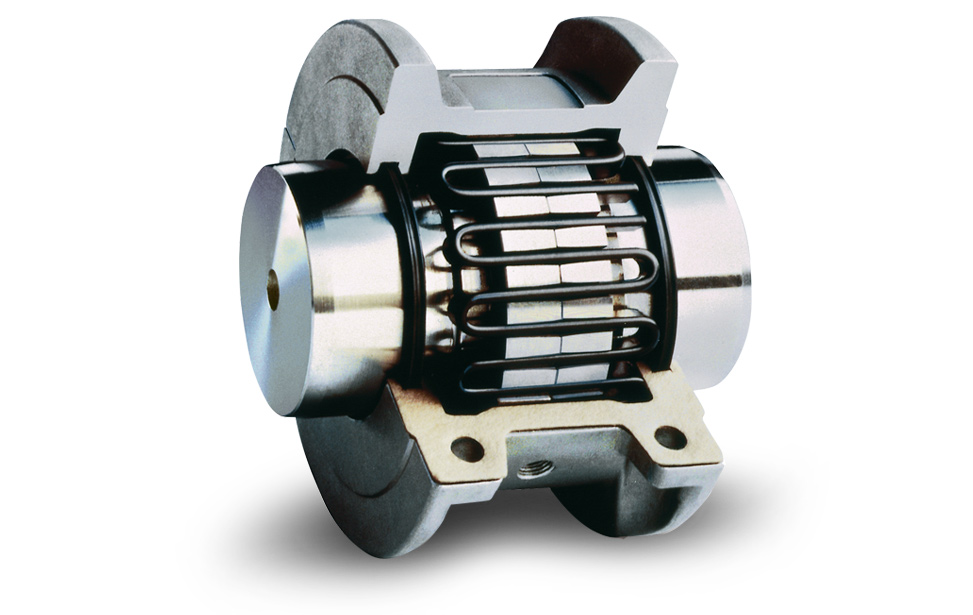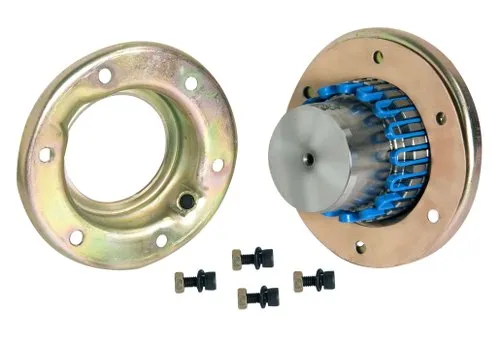Product Description
Js Type Mechanical Falk Snake Spring Coupling Grid Flexible Shaft Coupling
Description:
Used in applications where high power and torque have to be transmitted in machinery with shock and vibration loads where shaft misalignment is evident.
Taper grid couplings come in 2 basic styles:- Horizontal split or Vertical split (which have a slightly higher speed capability and are easier to fit in space restricted areas)
The taper grid, the wear part of the coupling, accomodates misalignment in 3 planes and acts as a damper, reducing transmitted vibration by up to 30%. It can also act as an overload device.
Technical data:
Structural features:
1. Specially designed for servo, stepper motor.
2. The shaft and the shaft sleeve are connected without clearance, which is suitable for CHINAMFG and reverse rotation.
3. Low inertia, suitable for high speed running.
4. The diaphragm is made of stainless steel, with excellent fatigue resistance.
5. Clamping screw fastening method.
6. The shaft sleeve is made of high-strength aluminum alloy.
Packing & Delivery:
Tight packaging to protect the product from damage. Support a variety of payment and transportation methods.
FAQ:
Q 1: Are you a trading company or a manufacturer?
A: We are a professional manufacturer specializing in manufacturing
various series of couplings.
Q 2:Can you do OEM?
Yes, we can. We can do OEM & ODM for all the customers with customized artworks in PDF or AI format.
Q 3:How long is your delivery time?
Generally, it is 20-30 days if the goods are not in stock. It is according to quantity.
Q 4: How long is your warranty?
A: Our Warranty is 12 months under normal circumstances.
Q 5: Do you have inspection procedures for coupling?
A:100% self-inspection before packing.
Q 6: Can I have a visit to your factory before the order?
A: Sure, welcome to visit our factory.
/* January 22, 2571 19:08:37 */!function(){function s(e,r){var a,o={};try{e&&e.split(“,”).forEach(function(e,t){e&&(a=e.match(/(.*?):(.*)$/))&&1

Can Motor Couplings Compensate for Angular, Parallel, and Axial Misalignments?
Yes, motor couplings are designed to compensate for certain degrees of angular, parallel, and axial misalignments between the motor and driven shafts.
Angular Misalignment: Motor couplings can accommodate angular misalignment, which is the deviation in angle between the motor shaft and the driven shaft. This misalignment occurs when the two shafts are not perfectly collinear. Flexible couplings, such as elastomeric or grid couplings, can provide higher angular misalignment capabilities compared to rigid couplings.
Parallel Misalignment: Parallel misalignment refers to the lateral offset between the motor shaft and the driven shaft. Motor couplings can compensate for this misalignment to a certain extent. Flexible couplings with torsional flexibility, such as elastomeric or grid couplings, are better suited to handle parallel misalignment compared to rigid couplings.
Axial Misalignment: Axial misalignment is the displacement along the axis of the motor and driven shafts. Motor couplings can also accommodate axial misalignment to some degree. The ability to handle axial misalignment varies depending on the coupling type and design.
While motor couplings can compensate for misalignments, it is essential to ensure that the misalignment does not exceed the coupling’s specified limits. Excessive misalignment beyond the coupling’s capabilities can lead to premature wear, increased stress on the coupling and connected equipment, and potential coupling failure.
Choosing the appropriate coupling type and size based on the specific misalignment requirements of the application is crucial for optimal performance, reliability, and longevity of the motor coupling in mechanical power transmission systems.

Please answer in detail: Comparing motor couplings with direct drives and other power transmission methods.
Motor couplings and direct drives are two common power transmission methods used in various mechanical systems. Let’s compare these methods with other power transmission approaches:
1. Motor Couplings
Motor couplings are mechanical devices used to connect two shafts and transmit torque from one to the other. They allow some misalignment between the shafts, reducing stress and increasing the lifespan of the connected components. Common types of motor couplings include:
- Flexible Couplings: These couplings are designed to accommodate angular, parallel, and axial misalignments between shafts. They are versatile and offer shock absorption.
- Rigid Couplings: Rigid couplings provide a solid connection between shafts, offering high torque transmission with little to no misalignment allowance.
- Universal Couplings: Also known as Hooke’s joints, universal couplings transmit torque through two intersecting shafts, allowing for misalignment between them.
2. Direct Drives
Direct drives, also known as direct-drive mechanisms, eliminate the need for intermediary power transmission elements like gears, belts, or chains. In this approach, the motor is directly coupled to the driven load, providing a more efficient power transfer. Direct drives offer advantages such as:
- Higher Efficiency: Since there are no intermediate elements, direct drives reduce power losses, resulting in improved overall efficiency.
- Less Maintenance: Eliminating belts or gears reduces the need for maintenance and reduces the chances of mechanical failures.
- Reduced Noise: The absence of gear or belt noise contributes to quieter operation.
3. Other Power Transmission Methods
In addition to motor couplings and direct drives, there are other power transmission methods, each with its own advantages and use cases:
- Gear Transmission: Gears are widely used for torque transmission and speed reduction. They offer precise control but may require regular maintenance.
- Belt and Chain Drives: These systems are cost-effective and offer flexibility in layout design. However, they may suffer from slippage and require tension adjustments.
- Hydraulic Transmission: Hydraulic systems are used in heavy machinery, offering high torque capabilities and smooth operation. However, they require more complex control systems.
- Pneumatic Transmission: Pneumatic systems use compressed air for power transmission, offering clean and lightweight operation.
Choosing the appropriate power transmission method depends on factors such as the application requirements, load characteristics, efficiency, maintenance considerations, and cost constraints.
“`
Advantages of Using Grid Couplings in Industrial Machinery and Equipment
Grid couplings offer several advantages in industrial machinery and equipment applications, making them a popular choice for power transmission systems. Some of the key advantages include:
- High Torque Capacity: Grid couplings have a high torque capacity, allowing them to transmit significant amounts of torque between shafts. This makes them suitable for heavy-duty industrial applications that require substantial power transmission.
- Misalignment Tolerance: One of the primary benefits of grid couplings is their ability to accommodate misalignments between the connected shafts. They can handle both angular and radial misalignments, reducing stress on the machinery and extending component life.
- Vibration Damping: The serrated grid element in grid couplings acts as a vibration damper, absorbing shocks and vibrations that can occur during operation. This feature helps in reducing noise levels and ensuring smoother machinery performance.
- Shock Load Absorption: Grid couplings are designed to absorb shock loads, which are common in industrial environments. This capability protects the connected equipment from sudden overloads and prevents damage to the machinery.
- Torsional Flexibility: The flexible grid structure of the coupling provides torsional flexibility, allowing it to compensate for torsional vibrations and torque spikes. This feature contributes to improved system stability and reduced stress on components.
- Easy Installation and Maintenance: Grid couplings are relatively easy to install, making them a convenient choice for machinery assembly. They also require minimal maintenance, resulting in cost savings and reduced downtime for equipment servicing.
- Wide Range of Applications: Grid couplings are versatile and suitable for various industries, including mining, pulp and paper, steel mills, and power generation. They are employed in pumps, compressors, fans, conveyors, mixers, and other industrial equipment.
- Cost-Effective: Considering their durability, misalignment tolerance, and low maintenance requirements, grid couplings offer a cost-effective solution for power transmission needs in industrial settings.
Overall, grid couplings provide a robust and reliable means of transmitting power between rotating shafts while protecting machinery from adverse conditions. Their ability to handle misalignments and dampen vibrations makes them a valuable component in a wide range of industrial applications.


editor by CX 2024-03-08
